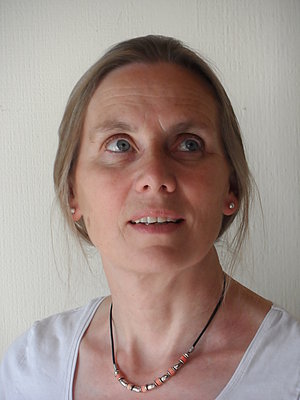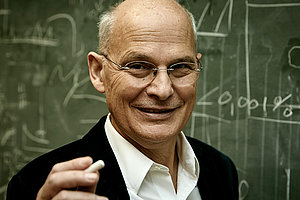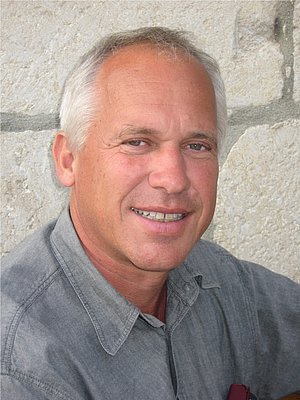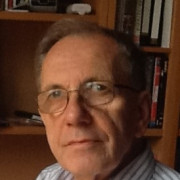Invited Talks Abstracts
Yeomans Beck Leibler Burda Frey Seifert Keim Posch Loerting Holovatch
Yeomans
Drops bounce easily on superhydrophobic surfaces because of low friction. We
discuss how the design of the surface can affect the bouncing, leading to a droplet
leaving the surface shaped as a flattened disc or an extended cylinder. Lattice
Boltzmann simulations and simple theories are used to help understand the reasons
behind the unusual bouncing pathways.
back to top
Beck
Many complex driven nonequilibrium systems are effectively described
by a superposition of several statistics on different time scales, in short a
‘superstatistics’[1,2]. A simple example is a Brownian particle moving in a
spatially inhomogeneous medium with temperature fluctuations on a large
scale, but the concept is much more general. Superstatistical systems typ-
ically have marginal distributions that exhibit fat tails, for example power
law tails or stretched exponentials. In most applications one finds three rele-
vant universaliy classes: Lognormal superstatistics, chi-square superstatistics
and inverse chi-square superstatistics. These can be effectively described by
methods borrowed from nonequilibrium statistical mechanics.
In this talk I will concentrate on some applications of this concept to bet-
ter understand the statistics of tracer particles embedded in a) classical fully
developed turbulent flows [3] and b) turbulent quantum liquids [4,5]. Some
rigorous mathematical proofs generalizing these ideas to invariant densities
of chaotic maps with slowly varying parameters have been recently obtained
in [6].
[1] C. Beck and E.G.D. Cohen, Physica A 322, 267 (2003)
[2] C. Beck, E.G.D. Cohen, and H.L. Swinney, Phys. Rev. E 72, 056133
(2005)
[3] C. Beck, Phys. Rev. Lett. 98, 064502 (2007)
[4] C. Beck and S. Miah, Phys. Rev. E 87, 031002(R) (2013)
[5] S. Miah and C. Beck, EPL 108, 40004 (2014)
[6] C. Penrose and C. Beck, Dyn. Systems 31, 89 (2016)
back to top
Leibler
During cooling, silica, the archetype glass-former gradually increases its viscosity over a wide
temperature range. Silica is not soluble. In striking contrast, all organic and polymer glass
forming liquids increase their viscosity and rigidify abruptly when cooled and are soluble. We
introduced the concept and synthesized, vitrimers, polymer materials that undergo gradual
glass transition like silica. Vitrimers are polymer networks that are able to change their
topology without changing the total number of bonds through thermo-activated catalytically
controlled exchange reactions. Solid at low temperatures and malleable when heated yet
insoluble whatever the temperature, vitrimers constitute the third class of polymers along with
thermoplastics and thermosets (elastomers). Since they can be shaped, assembled, repaired
and recycled just like the glass, besides opening intriguing perspectives in both physics and
chemistry, vitrimers should rapidly find applications in automotive, electronics, airplane, and
coatings industries.
back to top
Burda
In his famous book 'Capital in the Twenty-First Century' Thomas Piketty argues
that income tax is not able to reduce wealth inequalities because of the rate
of return on capital is greater than the rate of growth of economy.
He proposes to combine progressive income tax and wealth tax to prevent
inequalities from further growing.
In our talk we recall a simple model [by M. Mezard and J.-P. Bouchaud]
of macro-economy represented as a network of trading agents.
We extend the model by implementing taxation and redistribution to the system.
We identify three basic regimes from the point of the influence of trade
on wealth distribution:
(a) self-stabilizing regime in which trade reduces inequalities
(b) marginally stable regime in which trade weakly reduces inequalities
(c) rich-gets-richer regime in which trade augments inequalities.
In each case we analyze the effect of income tax and/or wealth tax
on wealth distribution. In particular we show that in case (c) any income tax
and redistribution are not able to inhibit wealth inequalities from growing.
back to top
Frey
Condensation phenomena occur in many systems, both in classical and
quantum mechanical contexts. Typically, the entities that constitute a system
collectively concentrate in one or multiple states during condensation.
For example, particular strategies are selected in zero-sum games, which are
generalizations of the children’s game Rock-Paper- Scissors. These winning
strategies can be identified with condensates.
In our work, we apply the theory of evolutionary zero-sum games to explain
condensation in bosonic systems when quantum coherence is negligible.
Only recently has it been shown that a driven-dissipative gas of bosons may
condense not only into a single, but also into multiple non-degenerate states.
This phenomenon may occur when a system of non-interacting bosons is
weakly coupled to a reservoir and is driven by an external time-periodic force
(Floquet system). On a mathematical level, this condensation is described by
the same coupled birth-death processes that govern the dynamics of
evolutionary zero-sum games. We illuminate the physical principles underlying the condensation and find that the vanishing of relative entropy production determines the condensates. Condensation proceeds exponentially fast, but the sys- tem of condensates never comes to rest: The occupation numbers of condensates oscillate, which we demonstrate for a Rock-Paper-Scissors game of condensates.
back to top
Seifert
Stochastic thermodynamics provides a framework for describing a large class of small driven systems. Examples are colloidal particles in time-dependent optical traps, single bio-molecules manipulated by optical tweezers or AFM tips, and transport through quantum dots. Thermodynamic quantities like work heat and entropy production can be identified on the level of an individual stochastic trajectory [1]. Non-equilibrium steady states are characterized by constant external driving through non-equilibrium chemical potentials or external forces or flows with a concomitant entropy production rate. I will discuss our recent work dealing with fluctuations in such NESSs. First, I will show how hidden slow degrees of freedom give rise to a "fine-structured" fluctuation theorem [2]. Second, I will show that constraining such fluctuations in order to have a more "precise" process inevitably requires a higher thermodynamic cost since for any isothermal process the product of its uncertainty and the free energy dissipated in it is larger than 2 k_B T [3]. Finally, I will introduce a new class of constraints bounding extreme current fluctuations in arbitrary Markovian networks [4].
[1] For a review: U.S., Rep. Prog. Phys. 75, 126001, 2012.
[2] P. Pietzonka, E. Zimmermann, and U.S., EPL, 107 , 20002, 2014.
[3] A.C. Barato and U.S., Phys. Rev. Lett. 114, 158101, 2015.
[4] P. Pietzonka, A.C. Barato and U.S., in preparation.
back to top
Keim
The Kibble-Zurek mechanism describes the evolution of defects and domains when a system is forced through a phase transition with spontaneously broken symmetry. It is used to describe transitions on such different scales like the Higgs field in the early universe shortly after the Big Bang [1] or in condensed matter systems like quenched quantum fluids [2]. Cooling at a finite rate, a domain structure naturally arises for a system with continuous phase transition. Since diverging correlation lengths are accompanied with critical slowing down, the system has to fall out of equilibrium for any non-zero rate in the vicinity of the transition. At this so called fall out time, a fingerprint of critical fluctuations is taken before the symmetry can switch globally.
Within this picture, we investigate the non-equilibrium dynamics in a soft-matter analogue, a two-dimensional ensemble of colloidal particles which in equilibrium obeys the Kosterlitz-Thouless-Halperin-Nelson-Young melting scenario with continuous phase transitions. The ensemble is exposed to finite cooling rates of the pair-interaction parameter (being an inverse system temperature) at very different rates from deep in the isotropic fluid into the poly-crystalline phase. We analyze defect configurations as well as the evolution of orientationally ordered domains quantitatively via video microscopy and show that their frozen-out length scale follows an algebraic decay as function of the quench rate as predicted [3].
[1] T. Kibble, J. Phys. Math. Gen. 9 1387 (1976)
[2] W. Zurek, Nature 317 505 (1985)
[3] S. Deutschländer, Proc. Natl. Acad. Sci. 112 6925 (2015)
back to top
Posch
Linearized hydrodynamics of one-dimensional particle systems is anomalous with respect
to their dynamical properties. Taking the fluctuating Burgers equation as a starting point,
we combine mode-coupling theory and exact results by Prähofer and Spohn
[J. Stat. Phys., vol. 115, 255 (2004)] to derive asymptotic expressions for the
time-correlation functions of the hydrodynamic modes and of their corresponding currents.
The results are compared to extensive computer simulations for two simple fluids with
short-range interactions. For the sound-mode sound-mode correlation function we find
good agreement. The still persisting deviatios for the current correlation functions are
shown to be strongly reduced by going to larger systems and longer times.
back to top
Loerting
back to top

Holovatch
It is well known that the conformation al properties of long flexible polymer chains in a good solvent are governed by power laws (scaling laws). The se arch for these laws lead not only to the c reation of modern theoretical physics and chemistry of polymers, but also enabled the discover y of a deep connection between the physics of critical phenomena and the physics of macromolecules. In this lecture, we discuss how do these laws change for polymers of complex topology (e.g. for polymer stars and networks), how they are modified under the influence of structural disorder (e.g. for polymers in crowded environment s in a cell or in a porous medium), h ow does the polymer composition influence the form of these laws. A t heoretical description of the above phenomena is established via a field-theoretic approach involving renormalization group analysis. Our results find application in description of various physical, chemical, biological phenomena where these laws are manifest. These in particular include the description of phase diagrams of complex polymers, diffusion-limited catalysis and trapping reactions, multifractality of interacting random and self - avoiding walks, properties of proteins in crowded environment of biological cells, and the DNA helix-to - coil transition.
back to top














